
A fiddle is a bowed string musical instrument, most often a violin. It is a colloquial term for the violin, used by players in all genres, including classical music. Although in many cases violins and fiddles are essentially synonymous, the style of the music played may determine specific construction differences between fiddles and classical violins. For example, fiddles may optionally be set up with a bridge with a flatter arch to reduce the range of bow-arm motion needed for techniques such as the double shuffle, a form of bariolage involving rapid alternation between pairs of adjacent strings. To produce a "brighter" tone than the deep tones of gut or synthetic core strings, fiddlers often use steel strings. The fiddle is part of many traditional (folk) styles, which are typically aural traditions—taught "by ear" rather than via written music.

Much has been learned about early music in Norway from physical artifacts found during archaeological digs. These include instruments such as the lur. Viking and medieval sagas also describe musical activity, as do the accounts of priests and pilgrims from all over Europe coming to visit St Olav's grave in Trondheim.
The polska is a family of music and dance forms shared by the Nordic countries: called polsk in Denmark, polka or polska in Estonia, polska in Sweden and Finland, and by several different names in Norway. Norwegian variants include pols, rundom, springleik, and springar. The polska is almost always seen as a partner dance in, although variants in 2
4 time, as well as in compound meters also exist.
Nordic folk music includes a number of traditions of Nordic countries, especially Scandinavian. The Nordic countries are Iceland, Norway, Sweden, Denmark and Finland.

Geirr Tveitt was a Norwegian composer and pianist. Tveitt was a central figure of the national movement in Norwegian cultural life during the 1930s.

Eivind Groven was a Norwegian composer and music-theorist. He was from traditional region of Vest-Telemark and had a background in the folk music of the area.
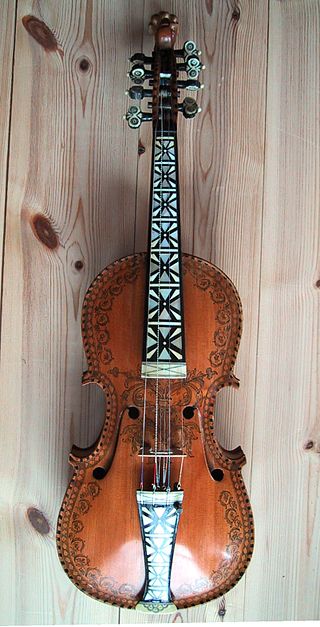
A Hardanger fiddle is a traditional stringed instrument considered to be the national instrument of Norway. In modern designs, this type of fiddle is very similar to the violin, though with eight or nine strings and thinner wood. The F-holes of the Hardanger fiddle are distinctive, oftentimes with a more "sunken" appearance, and generally straighter edges. Four of the strings are strung and played like a violin, while the rest, named understrings or sympathetic strings, resonate under the influence of the other four. These extra strings are tuned and secured with extra pegs at the top of the scroll, effectively doubling the length of a Hardingfele scroll when compared to a violin. The sympathetic strings, once fastened to their pegs, are funneled through a "hollow" constructed fingerboard, which is built differently than a violin's, being slightly higher and thicker to allow for these extra strings. The resonant strings lie on the center of the special bridge, attached to extra hooks on the tailpiece. Carved out within the center of the bridge is a smaller secondary "bridge", or opening, designed specifically for these resonant strings to pass through. This is where the resonance is picked up and reverberated; as notes are played, the vibrations are sent through the bridge, where the sympathetics echo those notes.

Hallingdal is a valley as well as a traditional district located in the traditional and electoral district Buskerud in Viken county in Norway. It consists of six municipalities: Flå, Nes, Gol, Hemsedal, Ål and Hol.
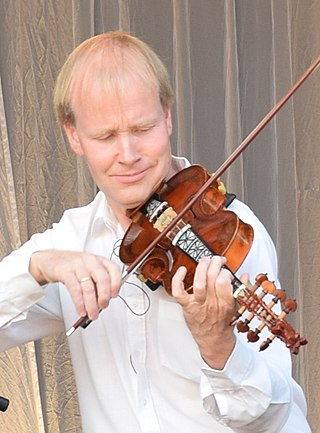
Arve Moen Bergset is a Norwegian traditional folk singer, hardanger fiddler, and classical violinist. He is known both for his solo works as well as for his works with Bukkene Bruse.

Traditional Nordic dance music is a type of traditional music or folk music that once was common in the mainland part of the Nordic countries — Scandinavia plus Finland. The person who plays this kind of music might be called speleman (Swedish/Norwegian), spelman (Swedish), spel(l)emann (Norwegian), pelimanni (Finnish) or spillemand (Danish). Finnish traditional dance music is often called pelimanni music in English, while there does not seem to exist a similar, widespread term for the corresponding music from the other countries. It is often more meaningful to distinguish between the traditional dance music from different regions than between music from the countries as such. Some concepts in the field can be defined as Norwegian or Finnish, but most are either common to all four countries or local. Besides the dance music tradition, all countries also have other traditions of folk music that are not shared to a similar extent.
Bygdedans is the regional, traditional dance of Norway. Bygdedans are the oldest and most distinctive among Norwegian folk dances.

Loretta A. Kelley is an American Hardanger fiddle player. She is President of The Hardanger Fiddle Association of America, and is described by her recording company as the foremost Hardanger fiddle player in the U.S.
Tom (Tammy) Anderson MBE (1910–1991) was a Scottish fiddler, teacher, composer and collector of traditional tunes. He has been described as "...the most prominent personality in the entire history of Shetland fiddling."
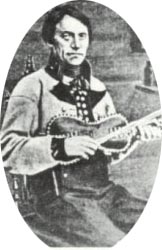
Torgeir Augundsson, better known as Myllarguten, is arguably the most acknowledged Norwegian folk musician to this day, and by far the most legendary. In his own local dialect, his given name is pronounced Targjei.
Kivlemøyane is the popular name of three dairy maids in Seljord, Telemark, who according to legend were turned to stone. Their image is presented in a natural formation in the mountain of Skorve in the valley Kivledalen. The legend also formed the basis for a number of Norwegian folk tunes.
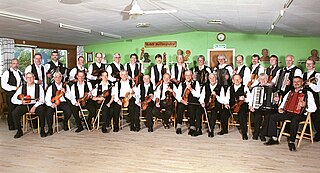
Danish traditional music is the music genre that has its roots in pre-modern Denmark. In this period it was common for towns to have one or more town musicians who played at dances, processions and certain rituals. In the 17th and 18th centuries, professional music performances were monopolized by town musicians, who also traveled into the neighboring rural areas to perform. Urban music and dance styles, often from other parts of Europe, penetrated the countryside and almost eradicated earlier styles. This period also saw the introduction of the fiddle as the most important instrument and the abandonment of earlier chain dances in favor of pair dances. Until around 1900, traditional music was the common musical culture of Denmark, but with increasing urbanization and the spread of classical music it became marginalized to rural areas.
Torleiv Bolstad was a Norwegian musician and Hardanger fiddle player. He won the Norwegian Landskappleiken four times, in 1947, 1957, 1970 and 1971.
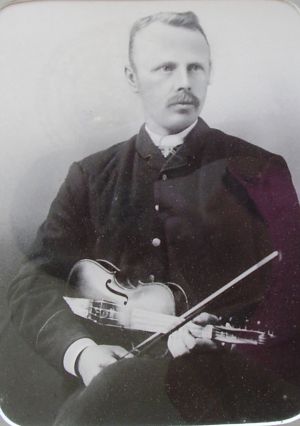
Nils Ellingsson Tjoflot was a Norwegian violinist from Tjoflot in the municipality of Ullensvang in Norway's Hardanger district.
Leonard Finseth (1911-1991) was a Norwegian-American fiddler from Mondovi, Wisconsin. He was well known for playing Old-time Norwegian dance music in his community, including waltzes, reels, schottisches, and polkas. He also recorded two albums: The Hills of Old Wisconsin and Scandinavian Old Time: Folk Fiddle from Wisconsin and was included in Scandinavian-American Folk Dance Music Vol. 2 and Across the Fields: Fiddle Tunes and Button Accordion Melodies. Other recordings of his music can be found at the Mills Music Library in Madison, Wisconsin.











